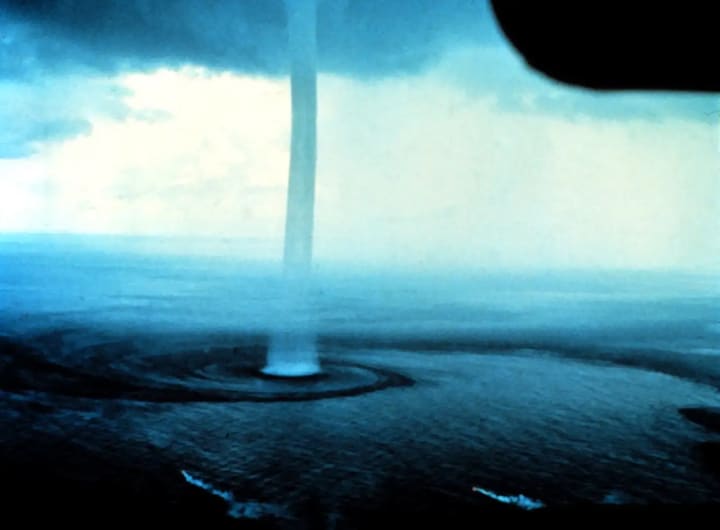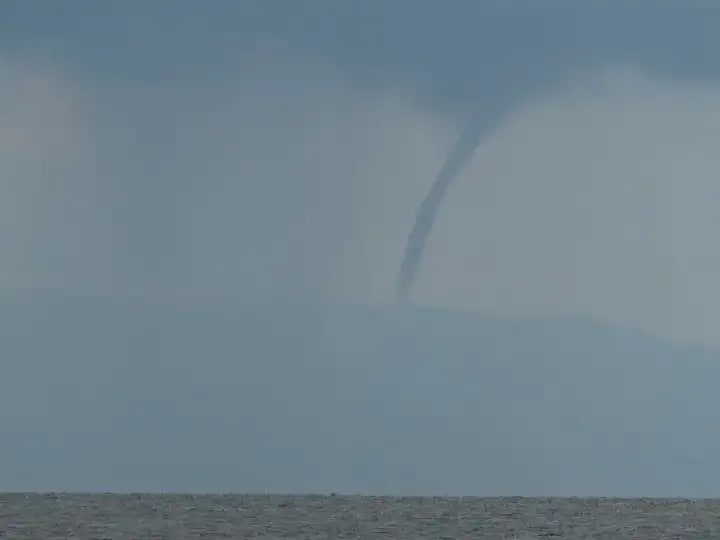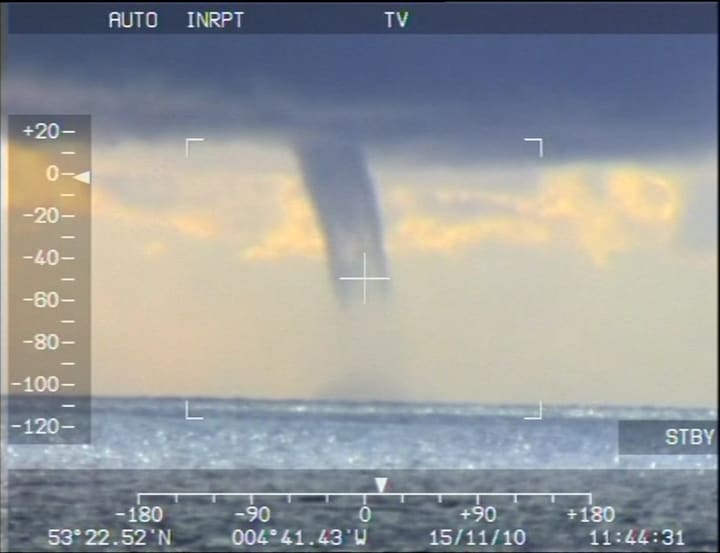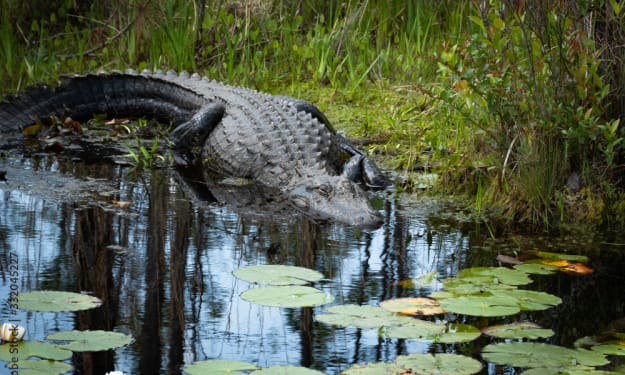Waterspouts
A chance spotting today - are they dangerous?

A chance spotting early this morning, my third sighting of a water-borne ‘tornado’. What makes these phenomena so interesting? Are they dangerous?

How it happened
At 06:30 this morning I headed up to the boat’s cockpit to sniff the morning air and drink my tea.
We need some water to top the tanks and I looked around for rain. Yesterday we’d only caught 15 litres and I’d used that trying to resolve a problem with my engine cooling system. We have enough water for at least a week — if I don’t use the engine. But light winds will not help us much and we need to move on.
The forecast for today is for light winds (yet again), 11% thunderstorm probability and 0.5 mm of rain, for half an hour. Not much hope of water there then.
I scanned the horizon and there it was. A shower, about five miles away.
And embedded in it was a waterspout.
Fortunately it wasn’t headed our way.
My first waterspout
I saw it when I was a boy in West Wales, out in Carmarthen Bay on a grey, rainy day, looking out to the southwest.
Then way back in 2013 I’d filmed one when in Malta, from a Marsascala apartment I was staying in while my boat was ashore in a boatyard for me to fix up (as always). It was a crappy video clip through a dirty window.
The Malta tornado in 1555 was the earliest record of a deadly waterspout. It struck the Grand Harbour of Valletta, sinking four galleys and numerous boats and claiming hundreds of lives. — Wikipedia
But today I was half a world away from Malta, at anchor in West Papua, New Guinea. And I had the First Mate’s good compact camera to hand. But the spout was at least five miles away. Quite close enough, thank you.
I certainly didn’t want a closer encounter.

Surprise
What surprised me was that it was early in the morning, before the sun had pumped up the atmosphere. Then I remembered that hurricanes, for example, are created in areas of high sea temperatures — the heat of the sea is what drives most of our weather systems as it is a huge reserve of thermal energy. Nighttime has no effect.
Where do they occur?
Hurricanes and tropical cyclones do not occur within about 10⁰ each side of the equator (which is why I’m currently in that zone, to avoid the Australian cyclone season). It seems counter-intuitive as that is where the sea is warmest, but other factors prevent hurricanes and cyclones forming in equatorial regions.

The sea surface temperature changes very little overnight and the NOAA chart shows it as over 30⁰ C in the Banda Sea (where I am).
Waterspouts form mostly in tropical and subtropical areas, but other areas also experience waterspouts, including Europe, Western Asia (the Middle East), Australia, New Zealand, the Great Lakes, Antarctica. Yes, and Wales, definitely.
So, a waterspout early in the morning — or even at night — should not be unusual in New Guinea. Or pretty much anywhere else it seems.

Then I wondered whether waterspouts rotated clockwise in the Southern Hemisphere (the plughole — Coriolis — effect) and I thought I’d look more closely at this phenomenon.
What is a waterspout?
A waterspout is an intense columnar vortex (usually appearing as a funnel-shaped cloud) that occurs over a body of water. Some are connected to a cumulus congestus cloud, some to a cumuliform cloud and some to a cumulonimbus cloud. In the common form, it is a non-supercell tornado over water having a five-part life cycle: formation of a dark spot on the water surface, spiral pattern on the water surface, formation of a spray ring, development of the visible condensation funnel, and ultimately, decay. — Wikipedia
The one I saw in Malta lasted for about three minutes. The one this morning I watched for over five minutes but I don’t know how long it had been spouting before I came on deck and noticed it.
How and when do they form?
Waterspouts fall into two categories: fair weather waterspouts and tornadic waterspouts.
Tornadic waterspouts are tornadoes that form over water, or move from land to water. They have the same characteristics as a land tornado. They are associated with severe thunderstorms, and are often accompanied by high winds and seas, large hail, and frequent dangerous lightning.
Fair weather waterspouts usually form along the dark flat base of a line of developing cumulus clouds. This type of waterspout is generally not associated with thunderstorms. While tornadic waterspouts develop downward in a thunderstorm, a fair weather waterspout develops on the surface of the water and works its way upward. By the time the funnel is visible, a fair weather waterspout is near maturity. Fair weather waterspouts form in light wind conditions so they normally move very little. — NOAA
So, there are ‘up’ waterspouts, and ‘down’ waterspouts.
Today’s was definitely the fair weather version.
Waterspouts exist on a microscale, where their environment is less than two kilometers in width. The cloud from which they develop can be as innocuous as a moderate cumulus, or as great as a supercell …They normally develop in moisture-laden environments as their parent clouds are in the process of development, and it is theorized they spin as they move up the surface boundary from the horizontal shear near the surface, and then stretch upwards to the cloud once the low level shear vortex aligns with a developing cumulus cloud or thunderstorm. — Wikipedia
The above clip is from Wikipedia. Click on a date/time to view the file as it appeared at that time. current 12:42…
Conditions have to be just right for them to form and the Szilagyi Waterspout Index can forecast those conditions. If you can pronounce it, you can use it.
Are they dangerous?
They say that bad things come in threes. I’m glad I wasn’t around for this little lot:

I certainly don’t want to find out the hard way. I’d be lowering sailing very quickly if these were on the horizon. But maybe I shouldn’t worry…
Most waterspouts do not suck up water; they are small and weak rotating columns of air over water. Although they are most often weaker than their land counterparts, stronger versions spawned by mesocyclones do occur — Wikipedia
…too much!
But NOAA’s advice is:
According to NOAA’s National Weather Service, the best way to avoid a waterspout is to move at a 90-degree angle to its apparent movement. Never move closer to investigate a waterspout. Some can be just as dangerous as tornadoes.
Play safe then.
Avoidance
If I’m at sea and I sea one of these buggers approaching then I’ll switch the radar on to track them — something we do anyway when trying to avoid squalls. It works at night too, when my weather eye doesn’t work so well.
These days though we’re usually looking for rain to top up our tanks — a sailing boat’s range is governed by the amount of fresh water it carries for her crew.
But as we’re in the rainy season it shouldn’t be too much of a problem. The buckets are out and the rain-catcher awning is up — at least until a waterspout arrives…
Look around
What do you see today? What’s in the sky — maybe a lot of snow if you’re in the US this week (December week 1, 2022)?
Asking that reminds me of a story from way back in 2003. It was a clear quiet night as we were crossing the English Channel from Portsmouth to France (same boat, same engine); John a new crew member and now a long time friend, pointed to the horizon where a faint red shape was showing.
“What’s that?” he said.
“That’s the moon rising” I replied.
He was a bright London city guy, with plenty of smarts, and he’d never seen the moon rise.
Look around. Be surprised. Just as I was this morning.
By the way, waterspouts do rotate according to the Coriolis effect.
Now I have to go and continue with my engine problem diagnosis so that in light winds I can at least use the engine to try and avoid waterspouts.
***

Canonical: This story was first published in Medium on 7 December 2022
About the Creator
James Marinero
I live on a boat and write as I sail slowly around the world. Follow me for a varied story diet: true stories, humor, tech, AI, travel, geopolitics and more. I also write techno thrillers, with six to my name. More of my stories on Medium
Enjoyed the story? Support the Creator.
Subscribe for free to receive all their stories in your feed. You could also pledge your support or give them a one-off tip, letting them know you appreciate their work.






Comments
There are no comments for this story
Be the first to respond and start the conversation.